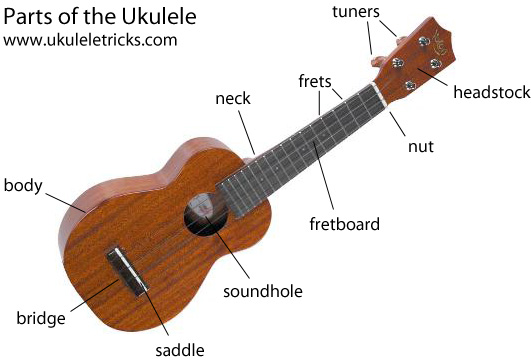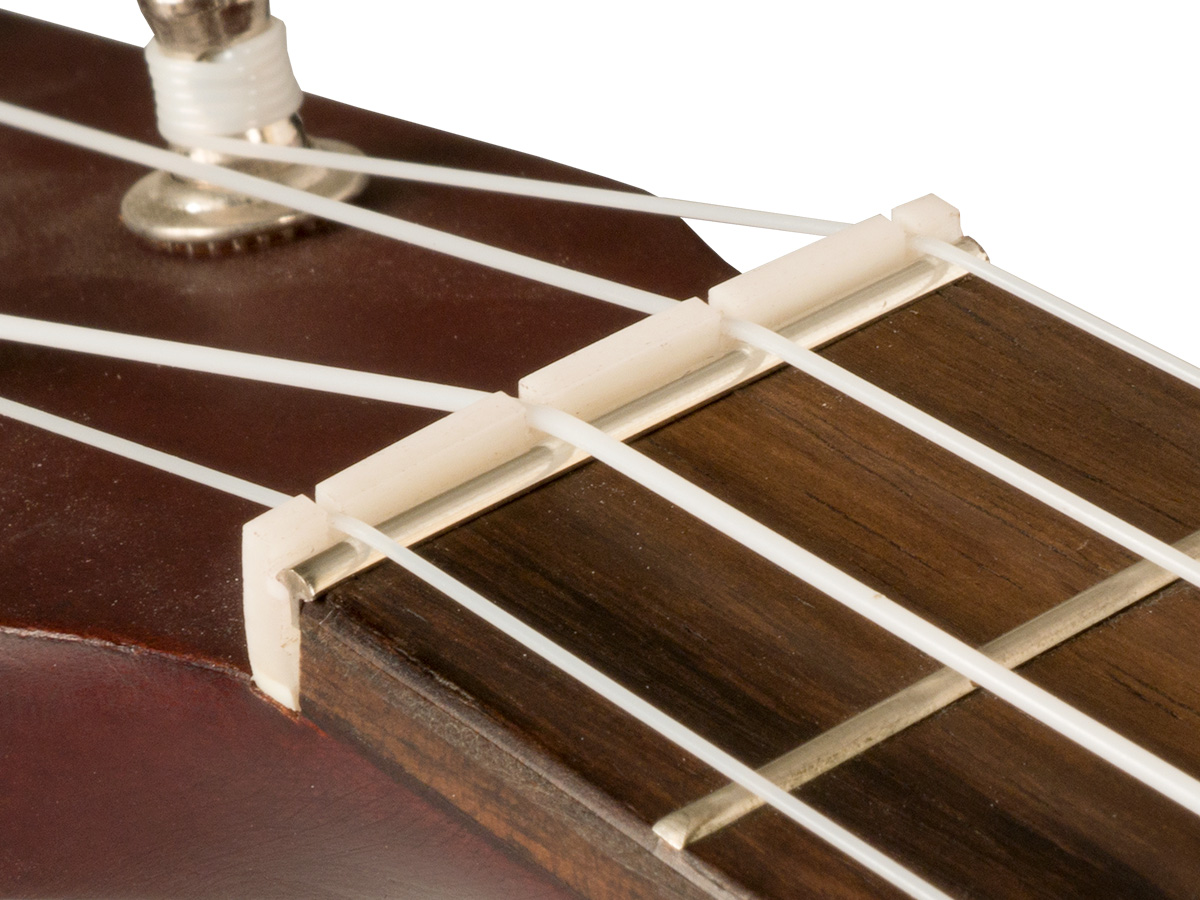The nut on a ukulele serves as a guide for the strings, ensuring proper spacing and height. It helps to maintain accurate pitch by anchoring the strings at the head of the instrument.
Understanding the components of a ukulele is essential for both players and enthusiasts. The nut, a small but crucial part located at the intersection of the fretboard and the headstock, plays a pivotal role in your instrument’s sound and playability.
These ridged pieces commonly made of bone, plastic, or even metal, not only support the strings but also set their intonation. Proper nut function ensures that the ukulele stays in tune as you play up and down the neck, producing the sweet, melodic tones the instrument is known for. Whether you’re an aspiring musician or a seasoned performer, knowing your ukulele’s anatomy, including the purpose of the nut, is key to mastering this charming and versatile instrument.

Credit: ukuleletricks.com
The Role Of The Nut In Ukulele Anatomy
The nut may seem small, but it’s a pivotal part of a ukulele’s anatomy. This integral piece sits right at the end of the fretboard. It plays a critical role in how a ukulele sounds and feels. Understanding the nut’s functions and materials gives insight into the instrument’s overall performance.
Essential Functions Of The Nut
The nut on a ukulele has vital duties. Here are its essential functions:
- String Spacing: It separates the strings evenly across the fretboard.
- String Height: It sets the height of the strings to prevent buzzing and allows easy playing.
- Tone Support: It helps shape the ukulele’s tone by influencing vibration transfer from the strings to the neck.
Material Choices And Sound Quality
Various materials affect a ukulele’s sound. Here’s a glimpse of options and their impact:
| Material | Sound Quality Influence |
|---|---|
| Plastic | Basic, suitable for budget ukuleles. |
| Bone | Enhances resonance, common in higher-quality instruments. |
| Tusq | Synthetic, consistent density, steady sound. |
| Metals | Bright tone, less common, durable. |
Design And Placement
The design and placement of the nut are crucial for a ukulele’s playability. Made from a variety of materials, the nut sits at the intersection of the ukulele’s headstock and fretboard. Its position directly influences tuning stability, string height, and overall tone.
Crafting And Positioning
Crafting the nut requires precision. Luthiers select materials such as bone, plastic, or ebony for optimal sound and durability. The nut must fit snugly at the ukulele’s top end, just below the headstock. Proper placement ensures the strings fan out evenly across the fretboard.
Impact On String Spacing And Action
The nut’s notches dictate string spacing. Precision here prevents strings from touching each other. It affects playability and reduces buzz. The nut’s height sets the action, aka the strings’ distance from the fretboard. A well-set nut action allows for comfortable playing with no extra strain on the fingers.
“`
Note: Content has been presented in HTML format suitable for WordPress, with each point adhered to the specified guidelines and complexity simplified for easier understanding.
Nut Maintenance And Common Issues
The nut of a ukulele plays a crucial role in your instrument’s sound. It’s the small strip located at the end of the neck where the headstock begins. It guides the strings onto the fretboard and maintains their spacing and height. Proper maintenance is vital for optimal performance. This section dives into essential care and tackles common nut-related issues.
Regular Cleaning And Care
Keeping your ukulele’s nut clean ensures longevity and quality sound. Dirt and oils from your fingers can accumulate over time, causing problems. To clean, use a soft cloth or an old toothbrush. Gently sweep away any debris. For tougher grime, dip the cloth in rubbing alcohol and rub it carefully across the nut. Avoid contact with the wood to prevent damage.
Troubleshooting Buzzing And Intonation
Sometimes you might hear a buzzing sound or notice intonation issues. This could be due to the nut. Check if it’s too low or if the grooves are worn out. Inspect for signs of uneven wear, which can affect string vibration. If the nut is too high, strings might be hard to press down causing intonation issues. A professional setup might be required if you’re unsure how to fix these problems.
- Buzzing: Determine which string is buzzing. The slot may be too wide, deep, or rough.
- Worn Grooves: Use a nut file to smooth out any rough spots. If the grooves are too deep, the nut may need replacing.
- High Action: The strings may be too high above the first fret, often fixed by adjusting the nut’s height.
| Issue | Possible Cause | Solution |
|---|---|---|
| Buzzing Strings | Too wide/deep grooves | Smooth with nut file or replace nut |
| High Strings | Nut set too high | Adjust nut or seek professional help |
| Random Intonation | Uneven wear | File or replace nut |
Pro tip: For maintenance, apply a bit of graphite from a pencil into the nut grooves. This helps the strings slide smoothly and can improve tuning stability.
Upgrading Your Ukulele Nut
Every ukulele player wants the best sound from their instrument. The nut may be small, but it’s mighty in impact. Upgrading the nut of your ukulele can be a game-changer for tone and playability. Keep reading to find out when to swap out your current nut and the types of materials that could elevate your uke’s performance.
When To Consider A Replacement
A nut’s health is vital to your ukulele’s overall sound and feel. Signs it’s time for an upgrade include:
- Frequent string buzzing: This nuisance often traces back to a worn-out nut.
- Difficulty in tuning: If strings slip or tuning is inconsistent, a new nut may help.
- Visible wear: Over time, nuts can crack or erode, leading to sound issues.
Regular players may notice these changes sooner. If you spot these signs, start thinking about a replacement.
Choosing The Right Material And Type
The material of your ukulele nut makes a big difference. Common options include:
| Material | Tone Quality | Durability |
|---|---|---|
| Plastic | Bright | Lower |
| Bone | Rich, Warm | Higher |
| Graphite | Smooth, Balanced | Moderate |
| TUSQ | Consistent Quality | High |
Think about the sound you want and how often you play. A bone nut is a classic choice for a well-rounded tone. TUSQ is synthetic but offers high quality and consistency. Balance your budget with your desired sound quality when making your choice. And remember, the right type of nut must fit your ukulele perfectly for optimal performance.
Do-it-yourself: Nut Adjustment And Replacement
Understanding the role of the nut in a ukulele is key to producing the best sound. Over time, its position may shift or the grooves might wear down, affecting the instrument’s playability. If you’re experiencing poor tone or tuning, it might be time for a nut adjustment or replacement. This DIY task can restore your ukulele’s performance, and you don’t need to be a luthier to accomplish it.
Tools And Techniques For Diy Adjustments
Before starting, gathering the right tools is essential. Here’s what you’ll need:
- Feeler gauges to measure nut slot depth
- Nut files to adjust the nut slots
- String winder for quick string removal
- Super glue or wood glue for securing the new nut
Techniques for smooth adjustments:
- Loosen the strings to access the nut.
- Use feeler gauges to check slot depths.
- Gently file to adjust the height, if necessary.
Step-by-step Guide To Replacing The Nut
Replacing the nut might sound daunting, but with careful steps, you can do it. Follow this guide:
- Remove strings using the string winder.
- Use a small block of wood and tap the old nut to loosen it.
- Clean the nut seat for the new nut.
- Test fit the new nut and make final adjustments.
- Apply a small amount of glue and set the new nut in place.
- Re-string and tune your ukulele.
With these steps, your ukulele will be back to creating beautiful music in no time!

Credit: goldtonemusicgroup.com
Frequently Asked Questions On What Does The Nut Do On A Ukulele
What Is The Most Important Part Of The Ukulele?
The most crucial part of the ukulele is the body, as it largely determines the instrument’s sound quality and resonance.
What Does Nut Width Mean On A Ukulele?
Nut width on a ukulele refers to the horizontal measurement of the ukulele’s neck at the top where the strings sit, impacting playability and finger spacing.
How Do You Adjust The Action On A Nut Ukulele?
To adjust the action on a ukulele nut, gently file the nut’s slots with a nut file. Ensure each slot’s depth holds the strings just above the first fret. Be cautious to avoid lowering the slots too much to prevent buzzes.
What Is 1.5 Nut Width On A Ukulele?
A 1. 5-inch nut width on a ukulele refers to the width of the ukulele’s neck at the nut, which impacts playability and string spacing.
Conclusion
Understanding the role of the ukulele nut reveals how essential it is for sound quality and playability. As the anchor for strings, it ensures tuning stability and precise pitch. Regular maintenance of the nut can significantly improve your instrument’s performance.
Remember, a properly functioning nut is key to a melodious ukulele experience. Embrace its importance and keep strumming those sweet, harmonious tunes!
